Peel And Stick Kitchen Countertop
In this age of easier home improvement solutions, it’s no surprise that it also extends to the kitchen. This is because it’s easy to upgrade, and one of the most heavily used spaces. For as far as kitchen renovations are concerned, the countertop will almost always come front and center. The issue with this though is that traditional countertops can be expensive. This is where peel and stick kitchen countertops come in.
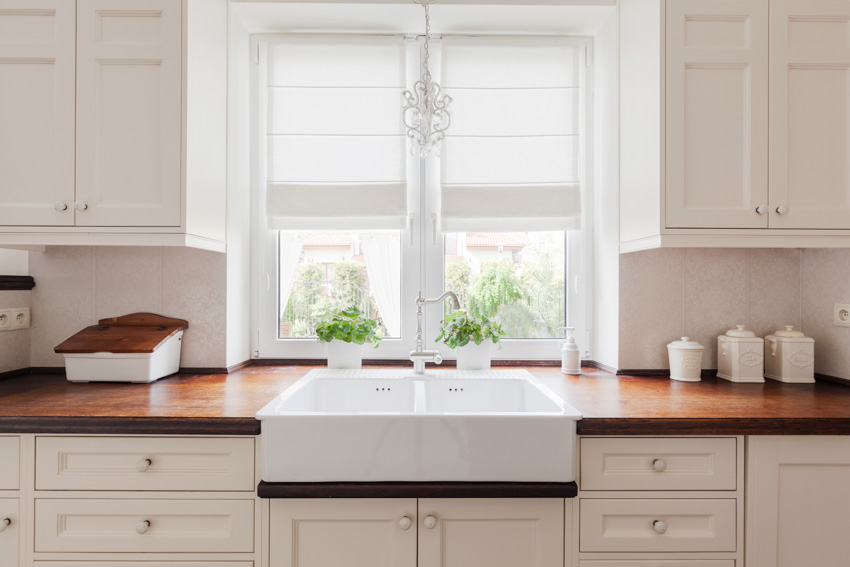
They come by many names. They can be called self-adhesive laminates, contact paper, peel-and-stick tiles, or just peel and stick countertops. They allow homeowners on a budget to upgrade old and tired-looking countertops by just “dressing them up”. It’s an economical option to an otherwise expensive upgrade so there really isn’t any reason not to love it.
Types of Peel and Stick Countertops
Peel and stick countertops are an inexpensive and quick way to put in a pop of color, add personality, or even mimic the look and feel of stone countertops in the kitchen. It costs only a fraction of the actual thing so as a practical homeowner, you get the best of both worlds for the budget and kitchen appearance.
They have surfaces that are easy to maintain and have been tested and proven to be incredibly durable. Here are some of the most commonly used types of peel and stick counter styles and what their different merits are.
Most of these adhesive tiles are made from vinyl material. Since it is water-resistant, durable, and easy to clean it makes an excellent substance for use in high-use areas like kitchens. Another option is PVC (Polyvinyl Chloride) which is similar to vinyl in its durability and cleanbility. Both of these materials can replicate the look of many different types of countertops.
Laminate options are available that have a thin layer of the material in the middle with a decorative print layer on top and an adhesive backing underneath. All of these options can fade over time, especially from direct sunlight, and are more susceptible to scratching than more permanent options.
Wood Countertop
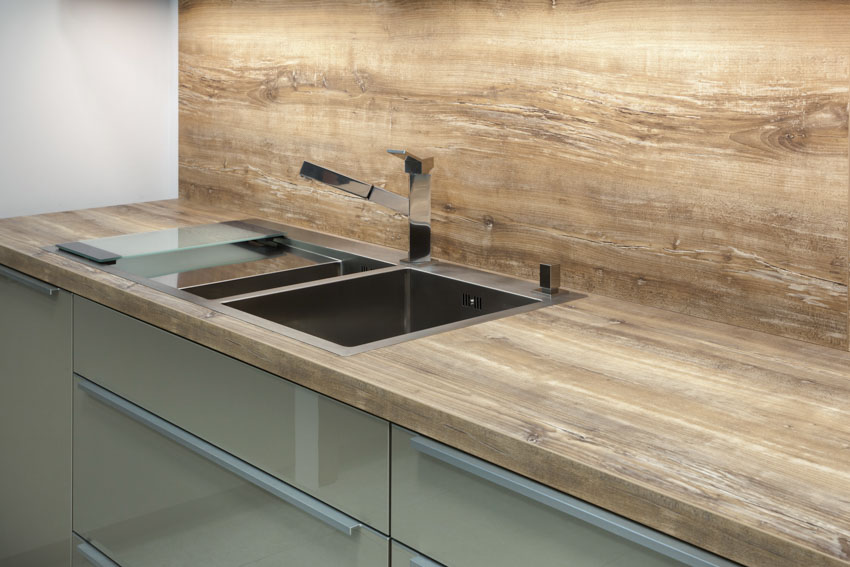
If you’re a fan of the natural look of wood but don’t really fancy the hefty price tag that comes along with it, you can opt for peel and stick faux wood kitchen countertops.
The look and feel of wood in the kitchen still come top of mind for most homeowners and interior decorators because of the fact that wood has warm undertones. This is a much-needed quality in the kitchen.
Bringing in a lot of sunlight and warmth in the elements involved in it can really brighten up the kitchen area and make the space look bigger and more inviting.
The market provides so many different types of wood tones, colors, or even patterns. You can go crazy and pick one that you like depending on the décor of your kitchen space.
What’s great about peel and stick wood countertops is that their designs are fluid. Wood goes with relatively anything.
You just need to pay a little attention to the colors as dark-colored peel and stick wood countertops can look heavy. You have to pair it with lighter-colored elements in the kitchen to make the overall design cohesive.
This is perfect if you’re opting for more natural-looking options in the kitchen or if you’re shooting for a rustic or farmhouse type of vibe.
Faux Granite
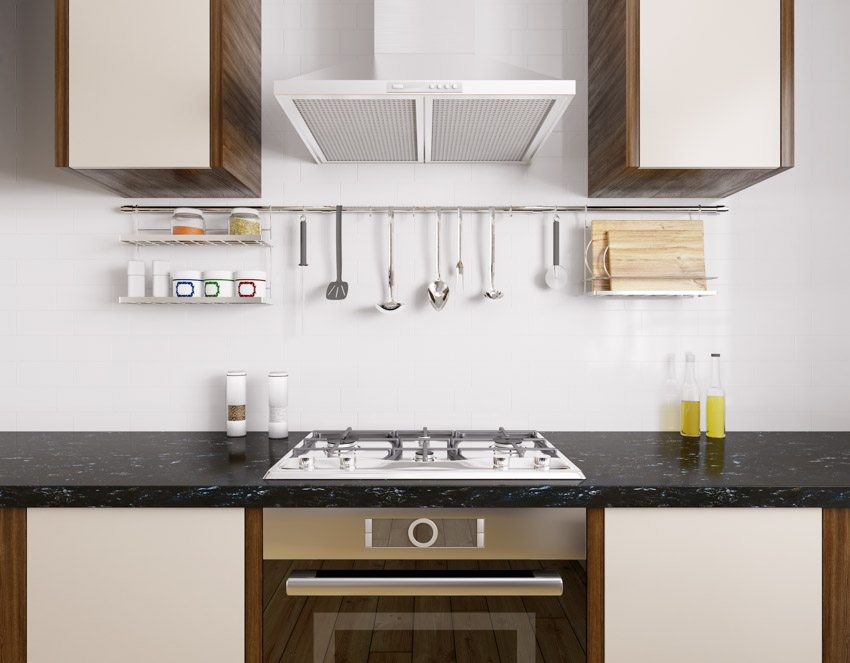
Fake granite peel and stick countertops are exactly as they sound like. The main goal is to mimic the beauty of this much-beloved natural stone.
There’s an understated sense of elegance in the appearance of natural stone in the kitchen and this is exactly what you’re shooting for when you’re opting for faux granite peel and stick countertops. It has a beauty that very few other countertop designs could match.
Faux granite countertops can take your kitchen to a whole new visual level without the crippling expensive costs that usually come along with real granite countertops.
There are over 20 different designs and shades of peel and stick granite countertops in the market right now and you’re bound to find something that will perfectly fit your kitchen design.
Faux Marble
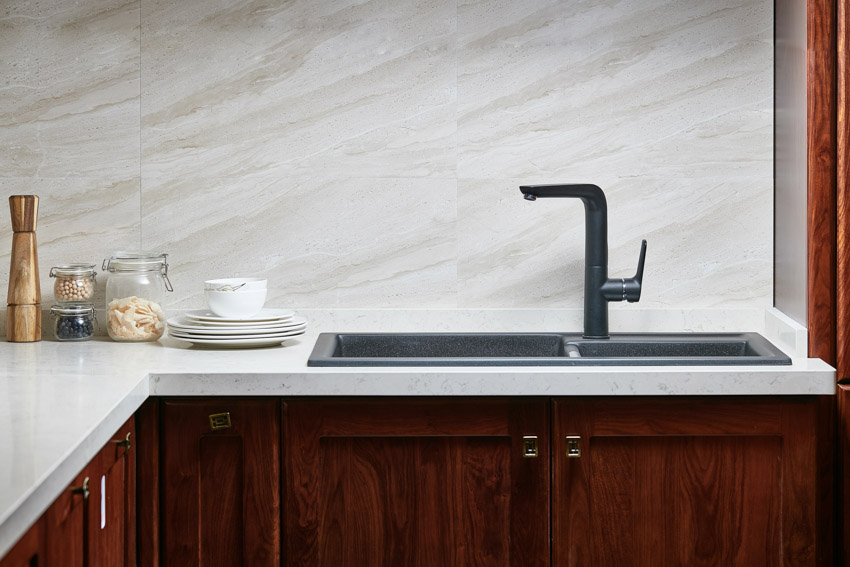
There are so many different types of faux marble peel and stick countertops available that it would be lengthy to dissect each and every single one of them.
One of the best ones in the market though is the flecked marble design. It’s easy to pair with relatively any paint color because it’s technically counted as a neutral.
It usually comes with a transparent vinyl layer that’s made out of PVC. This vinyl laminate contact paper is sold in rolls and can typically sustain heat up to 150 degrees.
This provides an extra layer of protection for your faux marble countertop, making it scratch-free and more durable. This also makes your faux marble peel and stick countertop easy to maintain as it would mean that you don’t have to do anything more than to just wipe it down to get it cleaned.
It is incredibly cheap and easy to install vinyl laminate yourself and it definitely is so much cheaper than real marble kitchen countertops, which you will only oftentimes see in very high-end homes.
One important tip is to buy a wider roll if possible to avoid extra seams in the counter surface. In addition you’ll want to carefully apply it from one edge to another taking care to smooth the surface as you go to avoid bubbles from forming in the material.
Tile Countertop
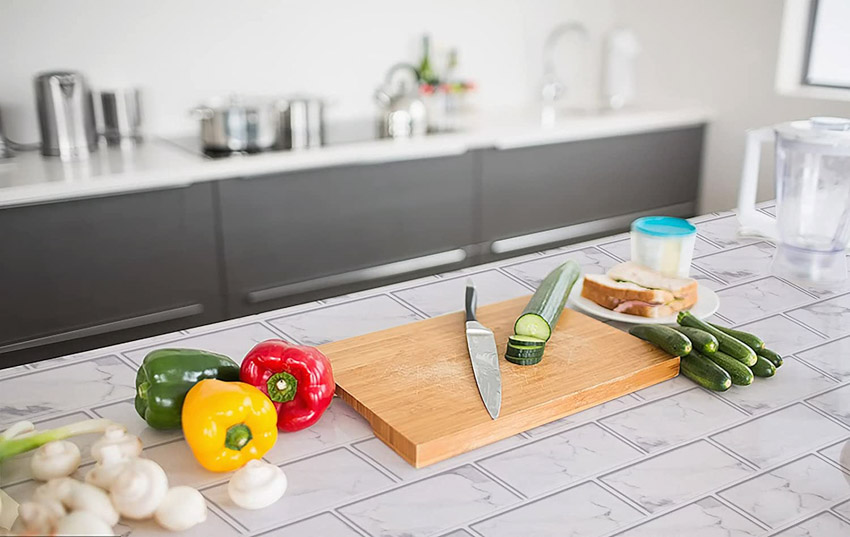
If you aren’t too fond of the wallpaper-like concept of faux wood and marble peel and stick types of kitchen countertops, you might want to consider something a little more durable.
A good example is a peel and stick tile countertop. They don’t cover an entire countertop like a removable wallpaper but are actually installed or adhered to in small tile sections, very similar to actual tiles.
You can buy a variety of different colors, patterns like subway tile, or have them mimic a material such as glass, copper or stainless steel.
They’re made of vinyl and aren’t just used for countertops but for backsplashes in the kitchen as well. Read more about peel and stick backsplash here.
Heat Resistant Countertop
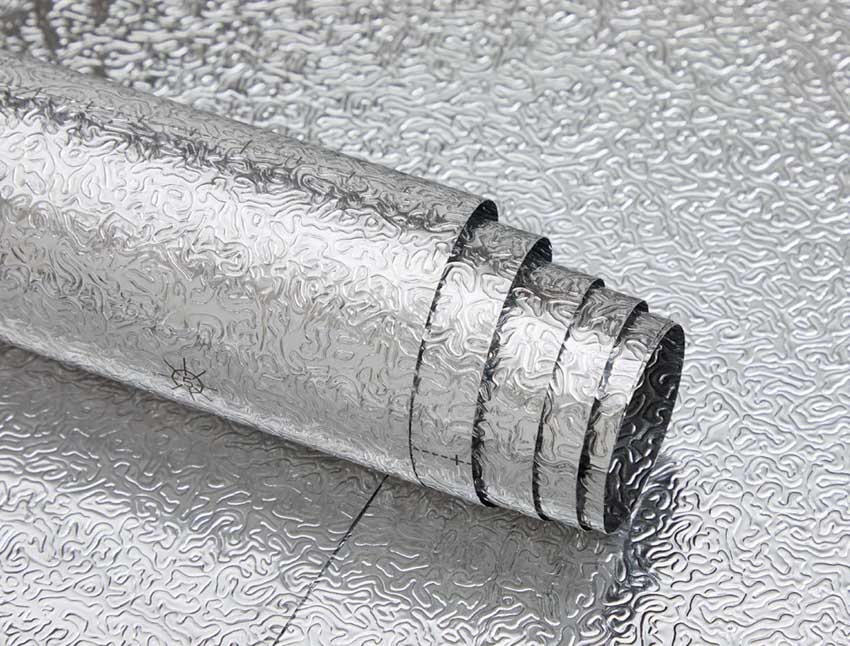
Heat-resistant peel and stick countertops are a notch higher compared to the typical or standard types in terms of the price range but it’s definitely something worth considering.
Even though you’re opting for a cheap option by not opting for a real stone or wood countertop, you’d still want it to last a long time and this is exactly what heat resistant peel and stick countertops address.
The kitchen is literally where the heat is. There will be a lot of times wherein you might end up accidentally setting down a hot pan or pot without the protective cushion and it would be a hassle if your peel and stick countertop suddenly melts and disintegrates upon contact.
Waterproof Countertop
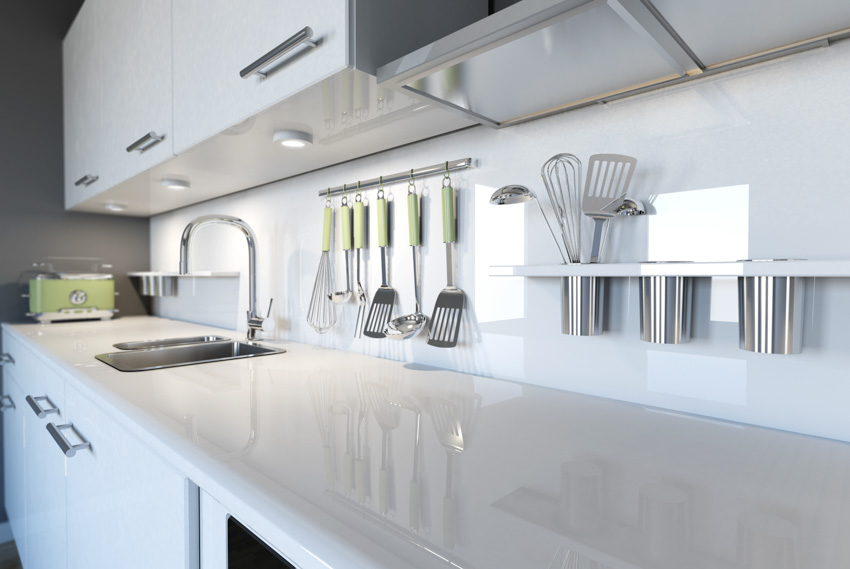
Most peel and stick countertops are waterproof by design. This is a necessity as you’ll need it to withstand the activities in the kitchen.
The decorative side usually has an extra plastic layer that’s clear and glossy and this provides protection against moisture, oil, and even stains.
This makes it really easy for you to maintain your peel and stick countertop as you wouldn’t have to do anything more than to just give it a good wipe-down and you’re all good to go.
Adhesive Countertop Buying Tips
Choose a high-quality material. Several types of materials are available on the market with different degrees of quality and durability.
There are many types to choose from but I would generally avoid using high gloss or high contrast finishes that look unnatural for a countertop surface.
Rather go for more neutral colors with a wood grain, metallic, or matte finish that resembles a real countertop material. Heat resistance should also be a quality to look for in a peel-and-stick countertop so they don’t immediately begin to curl up. Look for products that can resist 150 degrees in heat or more.
Measure your countertop before buying peel and stick material to avoid any excess or shortage. Consider the number of corners and edges when planning your installation.
How To Install Self-Adhesive Countertops

Here’s the details on how to properly install peel and stick countertops:
Clean and dry your countertops: Before applying a peel and stick material, ensure the countertop is clean and free of grime or grease.
Spray it with a degreaser to give it a more thorough clean. Scrub it vigorously to remove all debris and loose debris. Make sure the surface is completely dry before you move on to the next step.
Fill in Holes or Loose Materials: Low spots and divots can end up giving your adhesive tiles an uneven surface. You can fix it with some epoxy repair putty to fill in the different holes, dents, and other depressions on the surface area.
In addition any pieces that are lifting up should be secured with adhesive to ensure an even surface. Clamp loose areas with a C-clamp to help the adhesive make a secure bond.
For missing pieces make sure you apply some adhesive to the substrate and clamp it down with a C-clamp or with a heavy object until it dries out, properly securing the foundation of the countertop.
As a rule of thumb, allow the putty to dry out for 2 to 3 hours before resuming with your DIY project.
Even it out by sanding down the surface: Use 100-grit sandpaper to sand the surface down to make sure that it’s all smooth and even.
It’s easiest if you wrap a piece of sandpaper around a sanding block or a rectangular piece of wood or brick. Wipe away any debris created out of sanding the countertop surface down.
Apply primer to the surface: Porous surfaces can benefit from the application of primer to help with the adhesion of the peel-and-stick material. A solid base to stick to will also help reduce the dreaded peeling over time.
If you already have a smooth surface you may be able to skip this step. Not all types of peel-and-stick materials may need primer. Check to see if there are specific manufacturer instructions for the type you have to see if this helps with adhesion.
Lay the countertop materials: To get a feel for how if will look lay the peel and stick tiles or sheets in the orientation you want, making sure to avoid leaving any gaps between the edges. If your tile stickers have patterns take care to line up the edges so they look more natural.
Mark Your Cuts: Mark the areas or overlap with a grease pencil to cut with a utility knife. Make sure you have marked out cuts for the countertop its edges to provide full coverage.
Cut the areas marked: Carefully trim the excess materials with a utility knife using a metal straightedge as a guide to give an even and uniform look. You’ll want to cover the countertop and leading edges with peel and stick materials for best results.
If you’re using peel and stick tiles, stick your tiles down: Now for the fun part. Peel off the protective paper backing from your first tile and set it in place on the countertop surface. It’s practical to start off at a countertop edge and line them up accordingly.
Rub a clean piece of rag over the surface to help press the tile down and to get rid of residue and dust on its surface area as well. Make sure that the tiles are tightly affixed to each other with as little space in between as much as possible and trim off any excesses with a utility knife.
Another alternative to a peel and stick countertop is using rolls of contact paper. This is a type of adhesive paper that is typically used for decorative or functional purposes, such as covering surfaces like the inside of cabinets and drawers.
If you’re using a solid contact paper option, make sure that you do it a few inches at a time, and rub it down with a stiff flat surface such as a card, to get rid of any air bubbles along the way.
Press the in place with a heavy rolling pin. Once your peel and stick countertop has been adhered to, take out a heavy-duty rolling pin and press them in place with it. This will ensure that the rolls lay flat and don’t end up lifting or curling at the corners.
A peel and stick countertop is a thinner and less durable material that your typical countertop material. For those reasons peel and stick countertops are recommended for temporary or rental properties. It’s a good temporary solution while saving for an upgrade in the future.
Video on How to Install Contact Paper Countertops
Have you considered using a self adhesive peel and stick product for your kitchen makeover? Let us know your experience using these items, tools to make the job easier or other information you have in the comments. See more related content in our article about matching countertop and backsplash on this page.

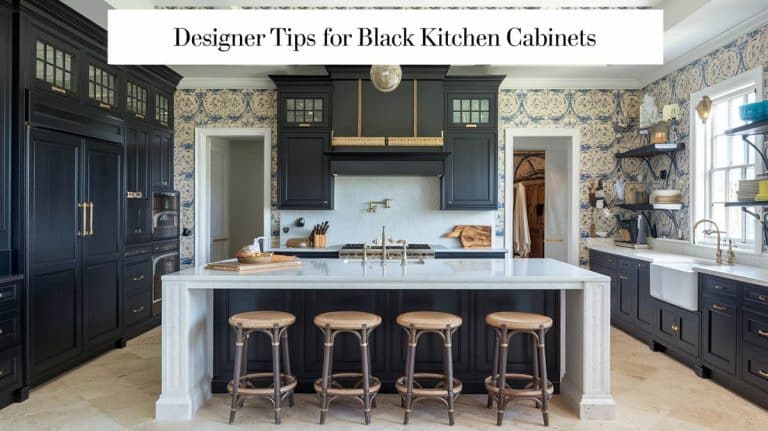
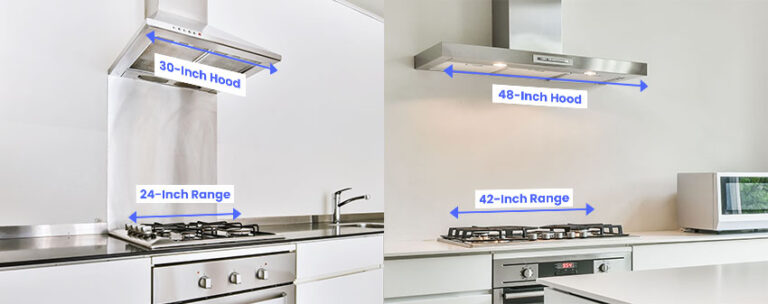
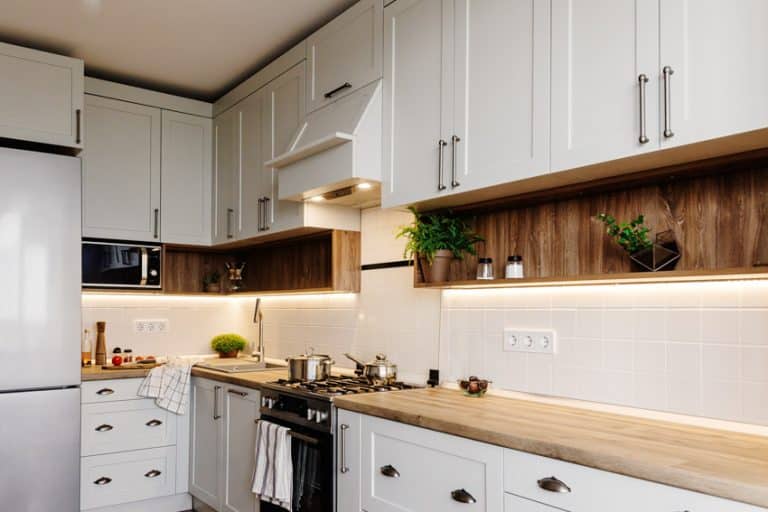
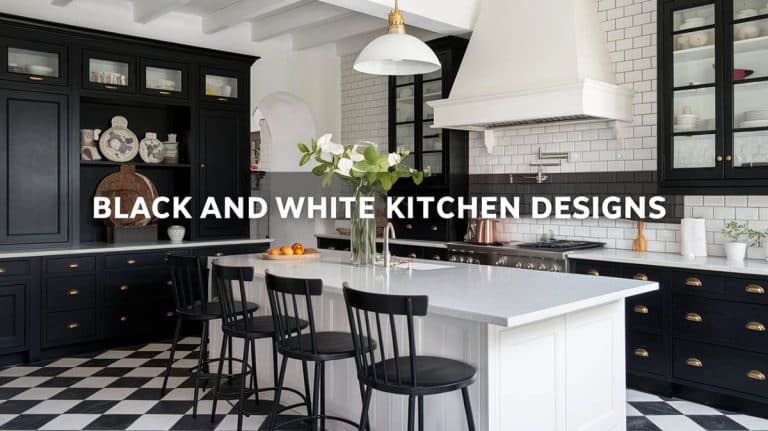
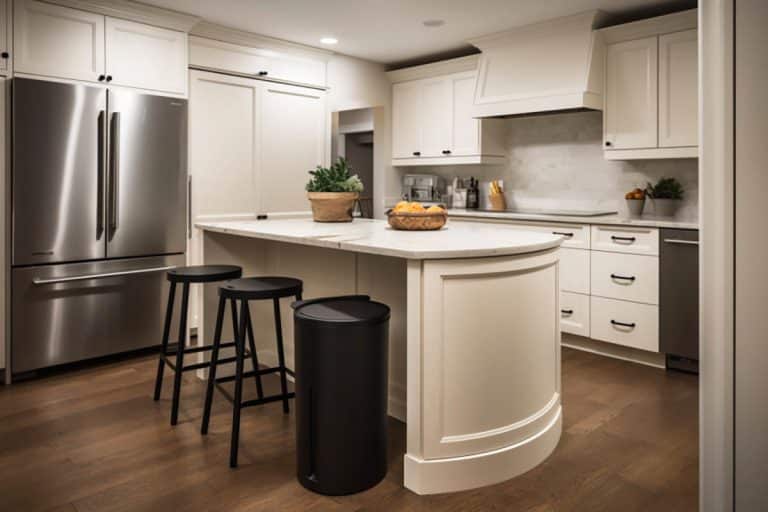

Should include detailed video of installing on countertops, bathroom vanity, etc. Have experienced person along with first-timer working together. Or have links to instructional videos